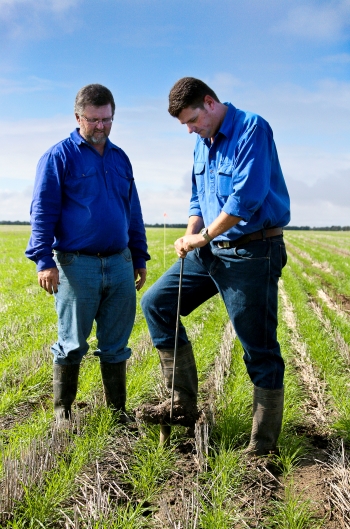Soil test to reap fertiliser value
Soil test to reap fertiliser value
Author: Toni Somes | Date: 09 Mar 2020

With many farm budgets looking tight following the run of desperately dry seasonal conditions, grain growers will be anxious to maximise the value of fertiliser expenditure this winter.
As one of the largest single variable costs for farming operations, it’s important that fertiliser programs are well planned in terms of requirement, product and placement to ensure they deliver dividends in crop yield and grain quality.
Incitec Pivot Fertilisers agronomist Bede O’Mara said the most effective strategy started with segmented soil testing to quantify the reserve of carry-over and mineralised nitrogen (N) and its position in the soil profile.
Mr O’Mara was speaking at the Grains Research and Development Corporation (GRDC) annual Grains Research Update in Goondiwindi, in southern Queensland, last week.
“It’s important to understand where you are in terms of N availability because even though generally it’s been very dry, it is possible that some mineralisation has occurred in areas that have seen small falls,” he said.
The mineralisation process converts N to plant available forms and is driven by soil temperature, moisture and levels of organic matter. Mineralisation generally occurs slowly during drought and increases strongly once it rains.
“Testing will be especially important in the 0-10 centimetre and 10-30cm bands as that’s where most of the mineralisation will have occurred with sporadic falls of rain,” Mr O’Mara said.
“However, N could also be sitting deeper in the soil profile – depending on the amount and intensity of falls, previous fertiliser applications or soil N could have moved to the 30-60 or 90cm profile depths, particularly if the soil was cracked and open prior to the rain.
“Basically, soil testing can remove the guesswork in terms of N requirements and the risk of unnecessary expenditure.
“If necessary, that spend can then be directed to other ameliorants such as gypsum or lime, or other nutrients such as phosphorus (P), zinc (Zn) and potassium (K) which may be limiting given the dry season and potentially low levels of Arbuscular mycorrhizal fungi (AMF).”
Previously known as vesicular arbuscular mycorrhizal or VAM fungi, AMF could be low on long fallow country which may affect a crop’s ability to access nutrients such as P and Zn.
AMF populations can suffer from a lack of host plant roots during long clean fallow periods or drought, with severe reductions showing up as a syndrome known as long fallow disorder – the failure of crops to thrive despite adequate moisture.
As crops vary in their ability to grow without the AMF fungi, crop selection is an important part of helping address low AMF situations.
Some crops such as winter cereals can grow in paddocks that are low in AMF while boosting AMF levels for the next crop. By comparison, crops such as linseed, sunflower, mungbean, chickpea, maize and sorghum all have over 50 per cent dependency on AMF and therefore yield may be compromised in paddocks where low AMF is an issue.
AMF levels can be assessed using PREDICTA® B testing, allowing growers to identify at-risk paddocks and if necessary, alter rotations to a crop less dependent on AMF and/or attempt to ameliorate paddocks with additional nutritional inputs such as P and Zn.
“At the end of the day, soil testing allows growers to make site specific objective judgements on the right treatment for each paddock and gives them the best chance to grow a productive and profitable crop,” Mr O’Mara said.
Fertiliser and soil nutrition management were key discussion topics at the Grains Research Updates in Queensland and New South Wales. Papers from the 2020 Updates are available
The PREDICTA® B service is delivered through the South Australian Research and Development Institute’s (SARDI) Molecular Diagnostic Centre, a state-of-the art facility capable of delivering high throughput diagnostic testing to industry. Investment in the Molecular Diagnostic Centre and the continued development of PREDICTA® B are components of the GRDC-SARDI strategic research partnership. SARDI is the research division of Primary Industries and Regions SA.
Contact Details
For Interviews
Bede O’Mara, Incitec Pivot Fertilisers
0417 896377
bede.omara@incitecpivot.com.au
Contact
Toni Somes, GRDC Communications Manager – North
0436 622 645
toni.somes@grdc.com.au
GRDC Project Code: ICN1906-003SAX,
